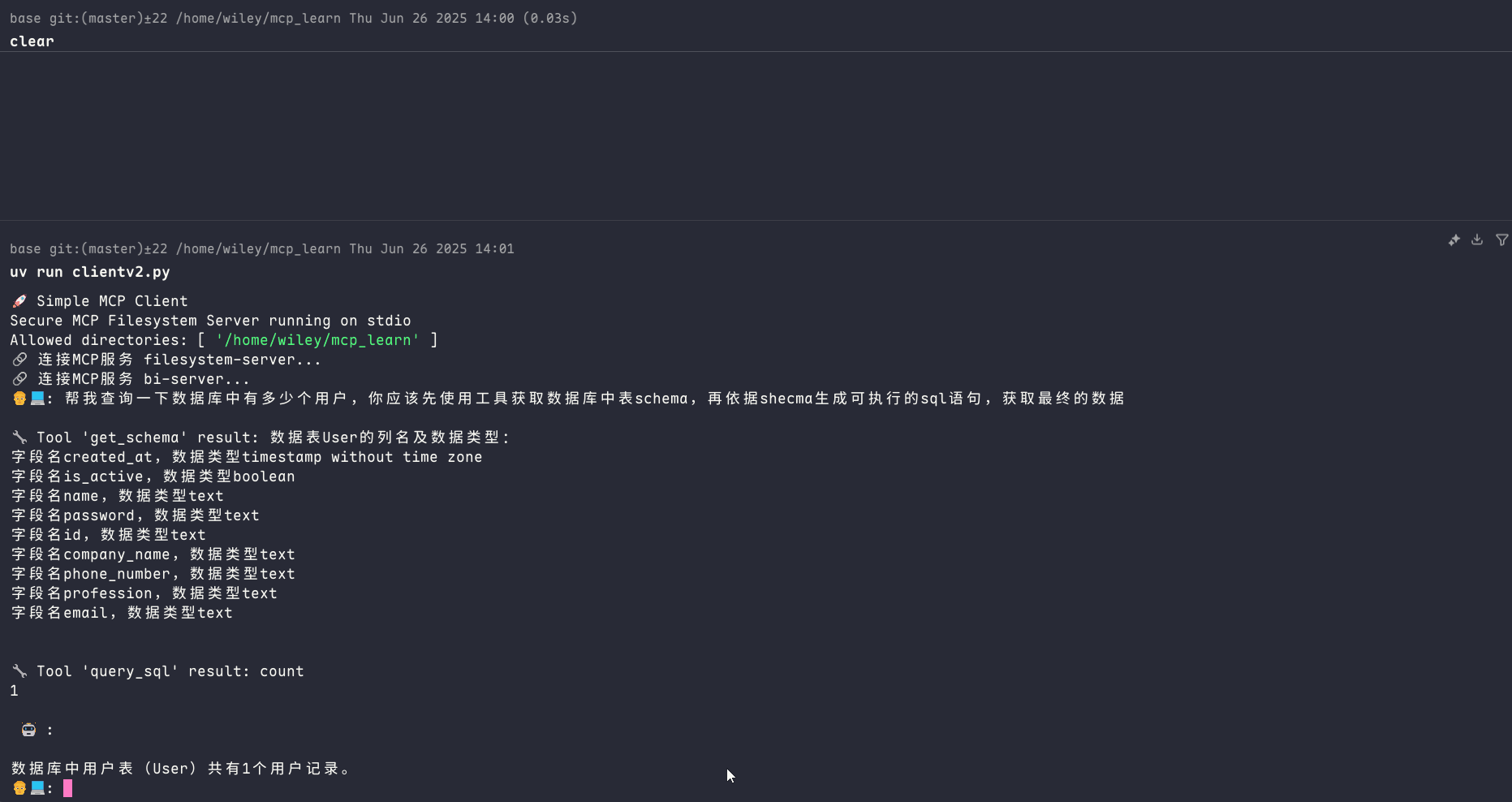
⚽ 编写支持VLLM部署Qwen3-32B的MCP Cleint/Server
MCP核心架构
MCP 采用了经典的 Client-Server 架构,各组件职责分明:
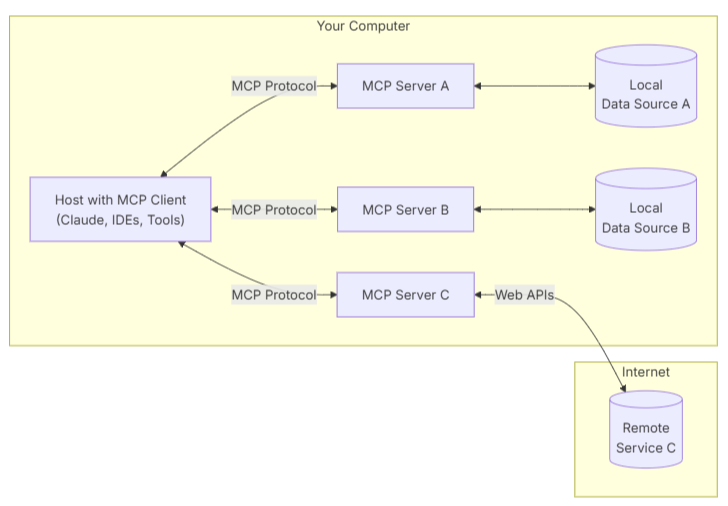
- MCP 主机 :AI Agent,是发出指令的“大脑”。例如 Claude Desktop、Cursor或你自己的 AI 应用。
- MCP 客户端 :通常内嵌于主机中,负责与服务器建立和维持连接,并处理协议层面的通信。
- MCP 服务器 :这是我们作为开发者主要构建的部分。它是一个轻量级程序,封装了对特定功能的访问,如操作数据库、读写文件等。
- 本地数据源 :服务器可以安全访问的本地资源,如计算机上的文件、数据库或服务。
- 远程服务 :服务器可以通过 API 等方式连接的外部系统。
MCP生命周期
MCP 的数据传输主要有两种方式,以适应不同的运行环境:
- stdio (标准输入/输出):客户端和服务器通过标准输入(stdin)和标准输出(stdout)进行通信。这种方式非常适合在同一台机器上运行的场景,例如,一个桌面 Agent 需要管理本地文件或控制浏览器,因为它简单、高效且无需网络配置。
- Streamable HTTP: 客户端和服务器通过流式 HTTP 进行通信。这是更通用、更灵活的方式,适用于服务器与客户端分离部署的场景(如部署在 Docker 容器或云服务器上)。它具有更好的网络兼容性和可扩展性。
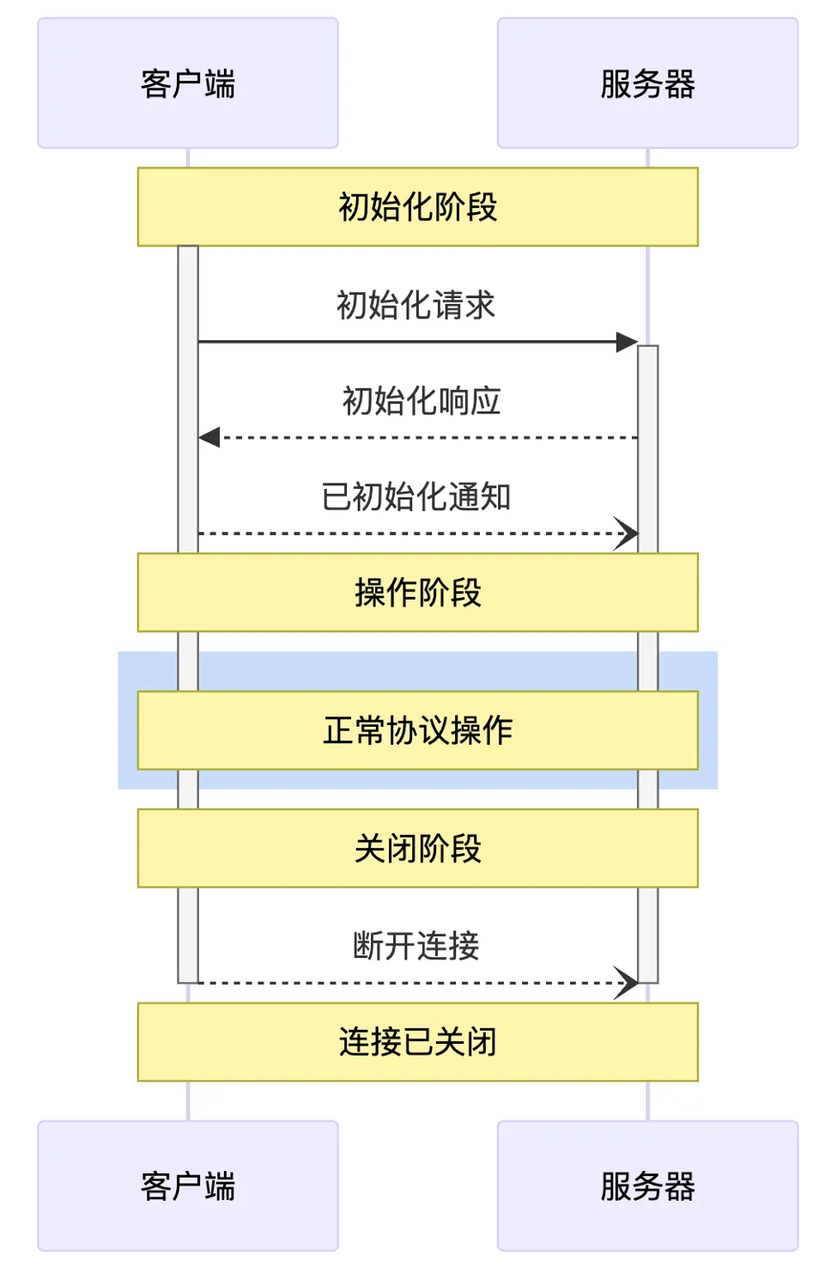
编写一个MCP Server
在开始之前,请确保你已经安装了必要的环境和库:
-
Python 3.10+
-
PostgreSQL 数据库:确保你有一个正在运行的数据库实例,并创建了相应的数据库和表(例如,一个名为
db的库中有名为User的表)。 -
安装依赖库:
uv add psycopg 'mcp[cli]'
初始化MCP Server
import psycopg from mcp.server.fastmcp import FastMCP from pydantic import Field app = FastMCP("bi")
Tool:定义一个可执行的动作
Tool 是客户端可以调用的函数,用于执行一个操作,比如查询数据库、发送消息或更新记录。它类似于 REST API 中的 POST请求。
description 参数至关重要,它会告诉 AI Agent这个工具是做什么的、什么时候该使用它,直接影响模型调用工具的准确性,使用类型标注与pydantic的Field描述参数。
@app.tool(description="使用 SQL 语句查询数据。") def query_sql(sql: str = Field(description="要执行的 SELECT SQL 语句")) -> str: if not sql: raise ValueError("缺少sql语句") with psycopg.connect("host=127.0.0.1 port=5432 dbname=db user=root password=123456") as db: with db.cursor() as acur: acur.execute(sql) if acur.description: columns = [desc[0] for desc in acur.description] formatted_rows = [] for row in acur: formatted_row = ["NULL" if value is None else str(value) for value in row] formatted_rows.append(",".join(formatted_row)) # 将列名和数据合并为CSV格式 return "\n".join([",".join(columns)] + formatted_rows) return "没有查询到数据"
Resource:暴露只读上下文信息
Resource 是服务器公开的只读数据或上下文,比如数据库的表结构、文件的元信息等。它类似于 REST API 中的 GET 请求。客户端通过一个唯一的 URI (schema://table) 来访问它。
@app.resource("schema://table") def get_table_schema() -> str: result = f"数据表User的列名及数据类型:\n" with psycopg.connect("host=127.0.0.1 port=5432 dbname=db user=root password=123456") as db: with db.cursor() as acur: acur.execute(f"SELECT column_name, data_type FROM information_schema.columns WHERE table_name = 'User';") for row in acur: result += f"字段名{row[0]},数据类型{row[1]} \n" # 将列名和数据合并为CSV格式 return result
Prompt:提供预设的提示词模板
Prompt 是预定义的提示词模板,可以帮助用户或 Agent 更轻松地处理和格式化数据,减轻编写复杂提示词的负担。
@app.prompt(name="to_echarts", description="将查询到的 CSV 数据整理为指定的 ECharts 图表。") def prompt_echarts(chart_type: str = Field(description="图表类型, 例如 'bar', 'line', 'pie'")) -> str: """生成一个提示,要求 LLM 将数据转换为 ECharts HTML。""" return f""" 你是一个数据可视化专家。请将上面通过'query_sql'工具查询到的 CSV 格式数据,转换为一个使用 Apache ECharts 库实现的「{chart_type}」图表。 要求: 1. 生成一个完整的、可直接在浏览器中运行的 HTML 文件内容。 2. ECharts 库通过 CDN 方式引入 (https://cdn.jsdelivr.net/npm/[email protected]/dist/echarts.min.js)。 3. 根据 CSV 的列名和数据,智能地设置 `xAxis`, `yAxis`, 和 `series`。 4. 代码需要包含在 ```html ... ``` 代码块中。 """
启动服务
采用streamable-http方式启动MCP Server
if__name__ == '__main__': app.run(transport="streamable-http", mount_path="/mcp")
调试
MCP 官方提供了一个基于 Web 的调试工具,可以方便地查看和调用 Server 暴露的功能。
- 确保已安装 Node.js 和 npm。
- 在终端中运行以下命令:
npx @modelcontextprotocol/inspector
- 复制启动日志中的链接访问web ui,在输入框中填入你的 MCP Server 地址 (
http://127.0.0.1:8000/mcp),然后点击 "Connect"。

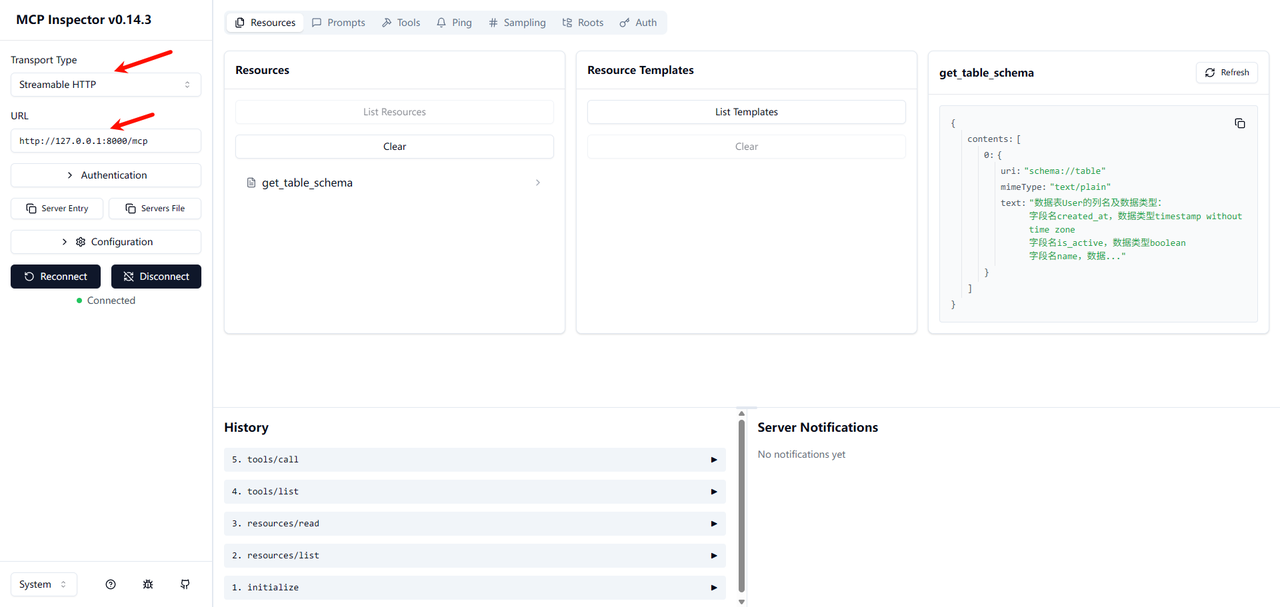
编写一个MCP Client
目前,生态中已经涌现出一些优秀的 MCP 应用,例如 Cursor, Cline, Warp, 和 Windsurf 等,你可以在 MCP 官方客户端列表(https://modelcontextprotocol.io/clients) 中看到它们的身影。
核心架构概览
在深入代码之前,我们先来了解一下客户端的整体架构。我们的客户端主要由两个核心类组成:
Server类: 负责管理单个 MCP 服务的生命周期。它处理连接的建立、工具的列出、工具的执行以及连接的优雅关闭。每个Server实例对应一个配置好的 MCP 工具提供方。Client类: 整个客户端的总指挥。它管理着一个或多个Server实例,负责从所有服务中收集工具,将其整合后提供给 LLM,并协调用户、LLM 和工具之间的对话流程。
整个交互流程如下:
- 启动与配置: 客户端读取
config.json文件,初始化所有在配置中定义的 MCPServer。 - 连接与发现: 客户端异步地连接到所有 MCP 服务,并请求每个服务提供其可用的工具列表。
- 格式转换: 由于 LLM(如 OpenAI API)的工具定义格式与 MCP 的原生格式不同,客户端需要进行一次转换,以便 LLM 能够“理解”这些工具。
- 对话循环:
- 用户输入问题。
- 客户端将对话历史和可用工具列表一起发送给 LLM。
- LLM 分析后,可能会选择直接回答,或者返回一个或多个工具调用(Tool Call)请求。
- 如果是工具调用,客户端会找到对应的
Server并执行该工具。 - 工具的执行结果会被格式化后,再次发送给 LLM。
- LLM 根据工具结果,生成最终的自然语言回答。
实战代码
在运行代码前,请确保你已经安装了必要的 Python 库:
uv add openai 'mcp[cli]'
配置文件config.json
{ "mcpServers": { "filesystem-server": { "command": "npx", "args": [ "@modelcontextprotocol/server-filesystem", "/home/wiley/mcp_learn" ] }, "bi-server": { "type": "streamable-http", "url": "http://127.0.0.1:8000/mcp" } } }
配置解析
filesystem-server服务: 这是一个stdio类型的服务。command: "npx" - 这意味着客户端会通过npx命令来启动这个工具服务。stdio模式非常适合将本地命令行工具包装成 MCP 服务。args: 传递给npx的参数。这里我们使用了一个社区提供的文件操作工具集。
bi-server服务: 这是一个streamable-http类型的服务, 是我们上一讲的课程demo。type: 指明连接类型。url: 该服务监听的 HTTP 端点。这种类型适合连接网络上持续运行的 MCP 服务。
代码详解:一步步构建客户端
话不多说,先上完整代码,再一步步解释。
import asyncio import json import logging import os import shutil from contextlib import AsyncExitStack from datetime import timedelta from typing import Any from mcp import Tool, StdioServerParameters, stdio_client from openai import OpenAI from mcp.client.session import ClientSession from mcp.client.streamable_http import streamablehttp_client from openai.types.chat import ChatCompletionMessageParam, ChatCompletionMessage openai_client: OpenAI = OpenAI(api_key="123456", base_url="http://192.168.11.199:1282/v1") def convert_mcp_to_openai_tools(mcp_tools: list) -> list: """将MCP Server返回的工具列表转换为OpenAI函数调用格式""" openai_tools = [] for tool in mcp_tools: tool_schema = { "type": "function", "function": { "name": tool.name, "description": tool.description, "parameters": {} } } input_schema = tool.inputSchema parameters = { "type": input_schema['type'], "properties": input_schema['properties'], "required": input_schema['required'], "additionalProperties": False } for prop in parameters["properties"].values(): # 特殊处理枚举值 if "enum" in prop: prop["description"] = f"可选值: {', '.join(prop['enum'])}" tool_schema["function"]["parameters"] = parameters openai_tools.append(tool_schema) return openai_tools class Server: """管理所有MCP Server的连接和工具执行""" def __init__(self, name: str, config: dict[str, Any]) -> None: self.name: str = name self.config: dict[str, Any] = config self.session: ClientSession | None = None self._cleanup_lock: asyncio.Lock = asyncio.Lock() self.exit_stack: AsyncExitStack = AsyncExitStack() async def initialize(self) -> None: """初始化所有 MCP Server""" try: # streamable-http 方式 if "type" in self.config and self.config["type"] == "streamable-http": streamable_http_transport = await self.exit_stack.enter_async_context( streamablehttp_client( url=self.config["url"], timeout=timedelta(seconds=60) ) ) read_stream, write_stream, _ = streamable_http_transport session = await self.exit_stack.enter_async_context( ClientSession(read_stream, write_stream) ) await session.initialize() self.session = session # stdio 方式 if "command" in self.config and self.config["command"]: command = ( shutil.which("npx") if self.config["command"] == "npx" else self.config["command"] ) server_params = StdioServerParameters( command=command, args=self.config["args"], env={**os.environ, **self.config["env"]} if self.config.get("env") else None, ) stdio_transport = await self.exit_stack.enter_async_context( stdio_client(server_params) ) read, write = stdio_transport session = await self.exit_stack.enter_async_context( ClientSession(read, write) ) await session.initialize() self.session = session print(f"🔗 连接MCP服务 {self.name}...") except Exception as e: logging.error(f"❌ 初始化错误 {self.name}: {e}") await self.cleanup() raise async def list_tools(self) -> list[Tool]: """从MCP Server列出所有工具""" if not self.session: raise RuntimeError(f"Server {self.name} not initialized") tools_response = await self.session.list_tools() return tools_response.tools async def execute_tool( self, tool_name: str, arguments: str, retries: int = 2, delay: float = 1.0, ) -> str | None: """执行工具""" if not self.session: raise RuntimeError(f"Server {self.name} not initialized") arguments = json.loads(arguments) if arguments else {} attempt = 0 while attempt < retries: try: logging.info(f"Executing {tool_name}...") result = await self.session.call_tool(tool_name, arguments) if result.isError: print(f"Tool error: {result.error}") print(f"\n🔧 Tool '{tool_name}' result: {result.content[0].text}") return result.content[0].text except Exception as e: attempt += 1 logging.warning( f"Error executing tool: {e}. Attempt {attempt} of {retries}." ) if attempt < retries: logging.info(f"Retrying in {delay} seconds...") await asyncio.sleep(delay) else: logging.error("Max retries reached. Failing.") raise return None async def cleanup(self) -> None: async with self._cleanup_lock: try: await self.exit_stack.aclose() self.session = None except Exception as e: logging.error(f"Error during cleanup of server {self.name}: {e}") class Client: def __init__(self, servers: list[Server]): self.servers: list[Server] = servers self.openai_tools: list[dict] = [] async def cleanup_servers(self) -> None: for server in reversed(self.servers): try: await server.cleanup() except Exception as e: logging.warning(f"Warning during final cleanup: {e}") async def get_response(self, messages: list[ChatCompletionMessageParam]) -> ChatCompletionMessage | None: """提交LLM,并获取响应""" try: completion = openai_client.chat.completions.create( model="qwen3_32", messages=messages, tools=self.openai_tools, tool_choice="auto" ) return completion.choices[0].message except Exception as e: error_message = f"Error getting LLM response: {str(e)}" logging.error(error_message) return None async def start(self): """开始MCP Client""" for server in self.servers: try: await server.initialize() except Exception as e: logging.error(f"Failed to initialize server: {e}") await self.cleanup_servers() return all_tools = [] for server in self.servers: tools = await server.list_tools() all_tools.extend(tools) # 将所有工具转为openai格式 self.openai_tools = convert_mcp_to_openai_tools(all_tools) await self.chat_loop() async def run(self, messages: list[Any], tool_call_count: int = 0, max_tools: int = 5): """获取LLM响应""" if tool_call_count > max_tools: # 强制结束并返回提示信息 return messages.append({ "role": "assistant", "content": "已达到最大工具调用次数限制" }) tool_call_count += 1 llm_response = await self.get_response(messages) result = await self.process_llm_response(llm_response) messages.append(result) if result["role"] == "tool": await self.run(messages, tool_call_count) return messages async def chat_loop(self): system_message = ( "你是一个帮助人的AI助手。" ) messages = [{"role": "system", "content": system_message}] while True: try: user_input = input("👨💻: ").strip().lower() if user_input in ["quit"]: logging.info("\nExiting...") break messages.append({"role": "user", "content": user_input}) result = await self.run(messages) reply = result[-1]["content"] print(f"\n 🤖 : {reply}") except KeyboardInterrupt: print("\n\n👋 Goodbye!") break except EOFError: break async def process_llm_response(self, llm_response: ChatCompletionMessage) -> dict: """""" tool_call = llm_response.tool_calls if tool_call: tool_call = tool_call[0].function logging.info(f"Executing tool: {tool_call.name}") logging.info(f"With arguments: {tool_call.arguments}") for server in self.servers: tools = await server.list_tools() if any(tool.name == tool_call.name for tool in tools): try: result = await server.execute_tool(tool_call.name, tool_call.arguments) logging.info(f"Tool execution result: {result}") return {"role": "tool", "content": result} except Exception as e: error_msg = f"Error executing tool: {str(e)}" logging.error(error_msg) return {"role": "assistant", "content": llm_response.content} async def main(): # 读取mcp server配置文件 with open("config.json", "r") as f: config = json.load(f) servers = [ Server(name, srv_config) for name, srv_config in config["mcpServers"].items() ] print("🚀 Simple MCP Client") client = Client(servers) await client.start() def cli(): """CLI entry point for uv script.""" asyncio.run(main()) if __name__ == "__main__": cli()
关键代码段解析
convert_mcp_to_openai_tools函数:- 作用: 这是连接 MCP 生态和 OpenAI API 生态的桥梁。此函数就是做个简单的转换。
- **
Server.initialize**方法:- 核心功能: 这是连接逻辑的所在。它通过判断
config中的type或command字段来决定使用streamable-http还是stdio连接方式。 - 资源管理: 这里使用了
contextlib.AsyncExitStack。它是一个异步的退出栈,可以确保我们进入的每一个异步上下文(比如stdio_client和ClientSession)在Server生命周期结束时,都会被正确地、按相反的顺序关闭。这极大地增强了程序的健壮性,避免了资源泄露。
- 核心功能: 这是连接逻辑的所在。它通过判断
- **
Server.list_tools**方法:- **获取所有工具:**使用mcp sdk提供的
session.list_tools()获取当前服务的工具
- **获取所有工具:**使用mcp sdk提供的
- **
Server.execute_tool**方法:- **执行工具调用:**使用mcp sdk提供的
session.call_tool调用指定工具,这里增加了重试次数
- **执行工具调用:**使用mcp sdk提供的
Client.get_response:- **调用LLM:**接收用户消息和工具列表,与LLM通信
Client.start:- **初始化MCP Server:**并获取所有工具,准备启动聊天
Client.chat_loop:- 用户输入: 启动聊天循环,接收用户简单的退出指令。
Client.run:- 多轮工具调用: **
run**方法通过一个递归,支持模型进行连续的工具调用(例如,先搜索信息,再根据信息写入文件),直到它认为任务完成或者达到最大调用次数限制。
- 多轮工具调用: **
Client.process_llm_response:- 处理LLM响应: 如果模型返回的消息为工具调用,则执行
execute_tool方法执行调用,否则直接回答用户。
- 处理LLM响应: 如果模型返回的消息为工具调用,则执行
本地测试
调用**bi-server**服务,获取数据库中的记录
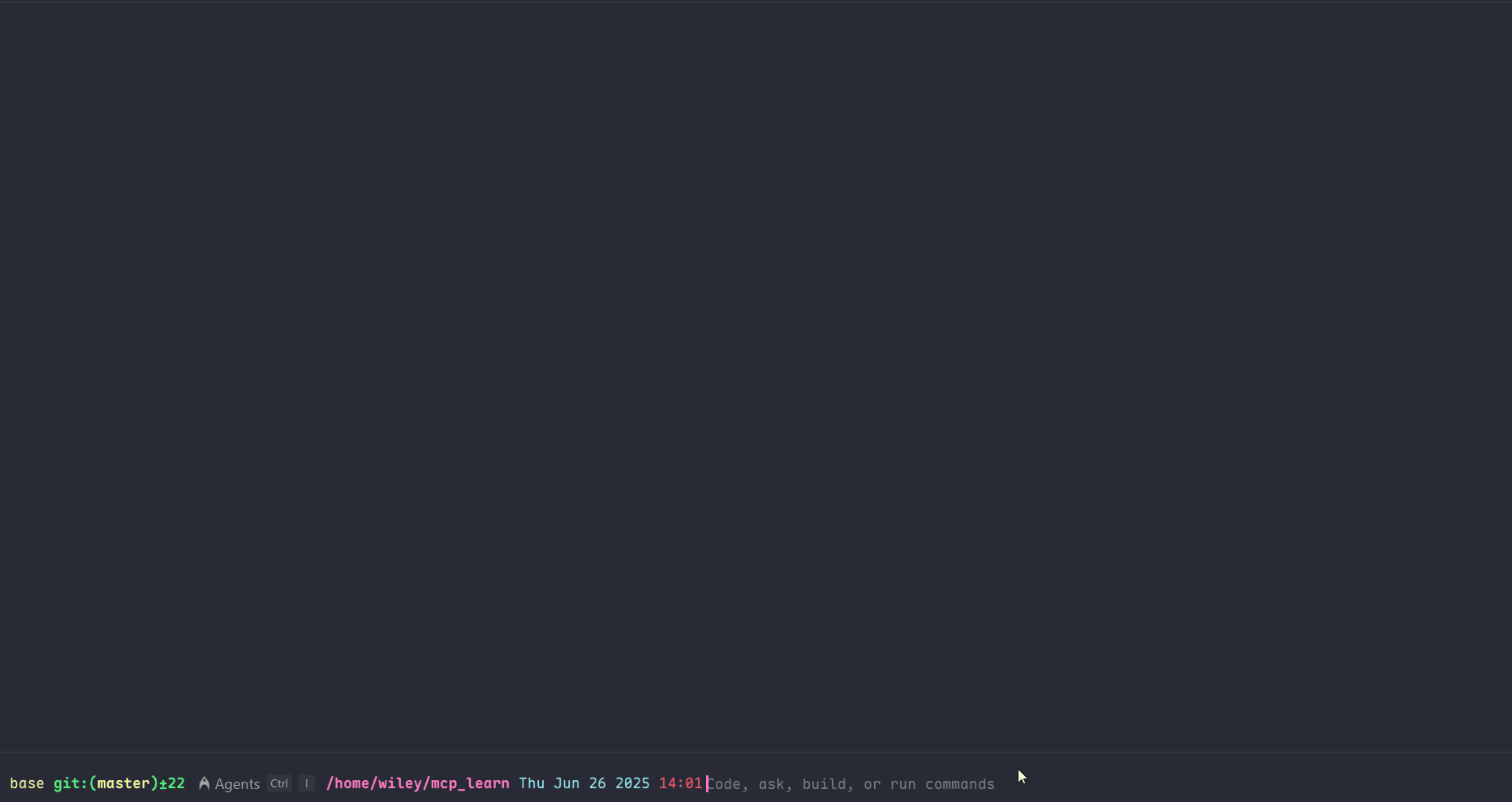
调用**filesystem-server**服务,查询数据用户信息,并写入本地文件
